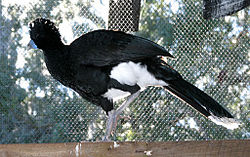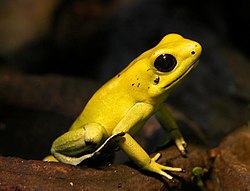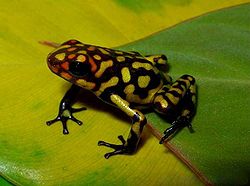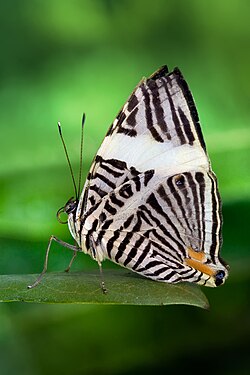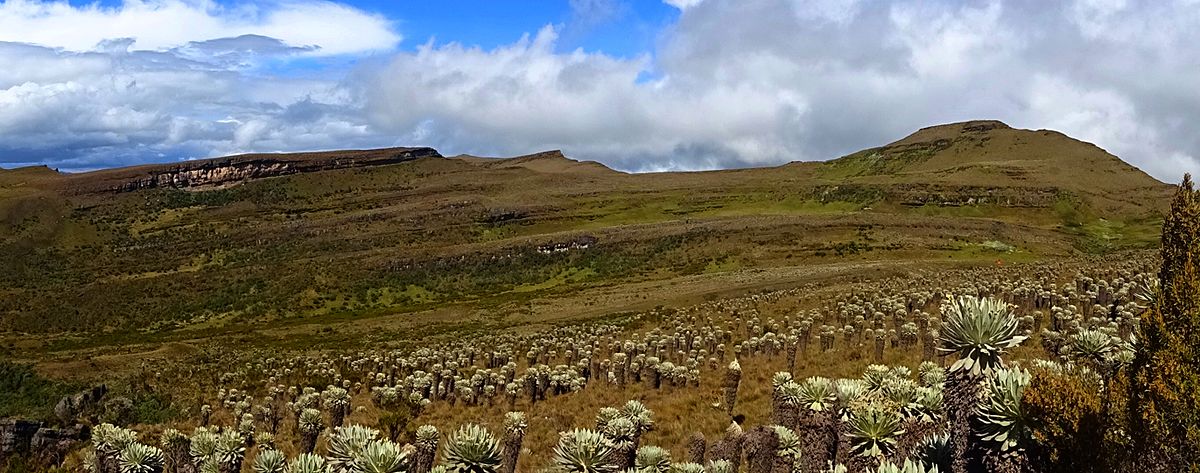Biodiversity of Colombia
From Wikipedia, the free encyclopedia
The biodiversity of Colombia is the variety of indigenous organisms in the country with the second-highest biodiversity in the world.[1] As of 2021, around 63,000 species are registered in Colombia, of which 14% are endemic. The country occupies worldwide the first position in number of orchids, birds and butterflies, second position in plants, amphibians and fresh water fish, third place in species of palm trees and reptiles and globally holds the sixth position in biodiversity of mammals.[2]
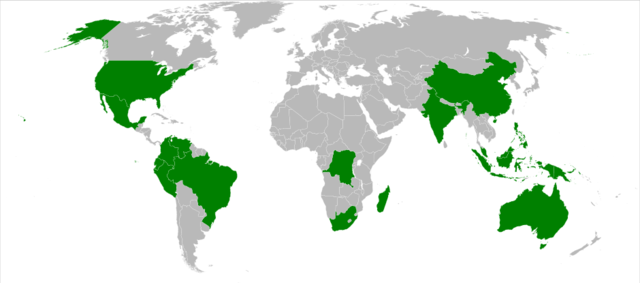

1 - Tropical Andes
5 - Tumbes-Chocó-Magdalena

The country hosts 59 nationally designated protected areas. At the establishment of the most recent addition, Bahía Portete – Kaurrele National Natural Park, Colombian president Juan Manuel Santos said "Biodiversity is to Colombia, what oil is for the Arabs".[3][4]
In 2020, according to the Colombian Biodiversity Information System, 63,303 species were registered in the country,[5] of which more than 8,800 are considered endemic species.[6][7][8] The country occupies the first position in the world in number of orchid and bird species, second in plants, amphibians, butterflies and freshwater fish, third in palm and reptile species, and fourth in mammalian biodiversity.
According to a report by the WWF, half of Colombia's ecosystems are in a critical state of deterioration or in a state of danger. The organization said that environmental degradation is due to oil extraction, mineral and metal extraction and deforestation. Deteriorating ecosystems are threatening the existence of more than a third of Colombia's plants and 50 percent of its animals.[9]
Since 1998, the Humboldt Institute for Biological Resources has been collecting biodiversity samples. As of 2014, 16,469 samples, representing around 2,530 species of 1,289 genera, and 323 families from Colombian biodiversity have been stored in its archives. [10]
Description
Summarize
Perspective
Colombia is one of seventeen megadiverse countries in the world.[7] The country in northwestern South America contains 311 types of coastal and continental ecosystems.[1] As of the beginning of 2021, a total of between 63,000 and 71,000 species are registered in the country,[8][5] with 8803 endemic species, representing near the 14% of the total registered species.[6] Colombia is the country with the most páramos in the world; more than 60% of the Andean ecosystem is found within Colombian territories.[11] Boyacá is the department where 18.3% of the national total area is located.[12] Since December 20, 2014, Colombia hosts 59 protected areas.[13] The biodiversity is highest in the Andean natural region, followed by the Amazon natural region.[14] Since 1998, the Humboldt Institute for Biological Resources in the country has been collecting samples of biodiversity. As of 2014, 16,469 samples, representing around 2530 species from 1289 genera, and 323 families of the Colombian biodiversity have been stored in their archives.[15]
The biodiversity of Colombia is at risk, mainly because of habitat loss, urbanisation, deforestation and overfishing.[16] According to a study of 2001, 260,000 hectares (640,000 acres) of forested area is lost every year.[17] Around 1300 species are critically endangered, and 509 species are introduced in Colombia, 22 of which are classified as invasive species in Colombia.[2] Various plans to address the environmental issues are proposed.[18] The National System of Protected Areas (SINAP) is the administrator of protected areas.
Biodiversity in numbers
| Class | Group | Pos | Species |
|---|---|---|---|
| Vertebrates | Mammals (list, primates) | 4 | 492 |
| Birds (list, endemic) | 1 | 1941 | |
| Reptiles (list, lizards, snakes) | 3 | 537 | |
| Amphibians | 2 | 803 | |
| Marine fish | 2000 | ||
| Freshwater fish (Magdalena River) | 1435 | ||
| Invertebrates (arthropods) |
Lepidoptera (butterflies, moths) | 1 | 3274 |
| Ants | 900 | ||
| Marine molluscs | 1250 | ||
| Marine sponges | 1250 | ||
| Corals | 139 | ||
| Marine decapods | 560 | ||
| Echinoderms | 296 | ||
| Terrestrial molluscs | 650 | ||
| Beetles | 7000 | ||
| Arachnids | 1089 | ||
| Bees | 398 | ||
| Diptera | 3153 | ||
| Flora (endemic) | Flowering plants | 22,840 | |
| Flowerless plants | 45 | ||
| Orchids (endemic) | 1 | 4270 | |
| Ferns and relatives | 1643 | ||
| Palm trees | 3 | 289 | |
| Mosses and relatives | 1649 | ||
| Algae | Terrestrial algae | 1030 | |
| Marine algae | 565 | ||
| Fungi | Lichen | 1674 | |
| Macrofungi | 1239 | ||
| Rusts | 327 | ||
| Smuts | 71 | ||
To commemorate the biodiversity of Colombia, the coins of the Colombian peso introduced in 2012 feature a species each.[19]
Natural regions
Colombia is divided into six natural regions.
Caribbean natural region
 |
Surface area | 132,288 km2 (51,077 sq mi) | |
| Departments |  | ||
| National parks | |||
| Biodiversity | aquatic birds | 165 | |
| amphibians | 39 | ||
| reptiles | 129 | ||
| plants | 3151 | ||
| fish | 109 | ||
| References | |||
Andean natural region
 |
Surface area | 282,540 km2 (109,090 sq mi) | |
| Departments | |||
| National parks | Catatumbo Barí Chingaza El Cocuy Corota Cueva de los Guácharos Doña Juana-Cascabel Los Estoraques Galeras Guanentá Las Hermosas Iguaque Nevado del Huila Los Nevados Las Orquídeas Otún Quimbaya Pisba Puracé Selva de Florencia Sumapaz Tamá Tatamá Yariguíes |  | |
| Biodiversity | aquatic birds | 14 | |
| amphibians | 485 | ||
| reptiles | 220 | ||
| plants | 11,500 | ||
| fish | 197 | ||
| References | |||
Orinoquía natural region
 |
Surface area | 285,437 km2 (110,208 sq mi) | |
| Departments | |||
| National parks | La Macarena Los Picachos Tinigua El Tuparro | 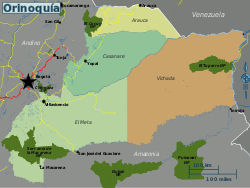 | |
| Biodiversity | aquatic birds | 92 | |
| amphibians | 57 | ||
| reptiles | 119 | ||
| plants | 2692 | ||
| fish | 619 | ||
| References | |||
Amazon natural region
 |
Surface area | 483,911 km2 (186,839 sq mi) | |
| Departments | |||
| National parks | 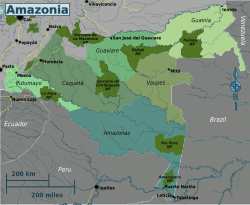 | ||
| Biodiversity | aquatic birds | 74 | |
| amphibians | 158 | ||
| reptiles | 195 | ||
| plants | 5300 | ||
| fish | 675 | ||
| References | |||
Pacific/Chocó natural region
 |
Surface area | 83,170 km2 (32,110 sq mi) | |
| Departments |  | ||
| National parks | Los Katíos Sanquianga Uramba Bahía Málaga Utría | ||
| Biodiversity | aquatic birds | 142 | |
| amphibians | 154 | ||
| reptiles | 177 | ||
| plants | 4525 | ||
| fish | 164 | ||
| References | |||
Insular natural region
 |
Surface area | 300 km2 (120 sq mi) | |
| Departments | 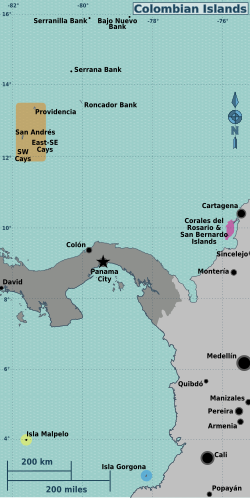 | ||
| National parks | Corales del Rosario Malpelo Old Providence Gorgona | ||
| Biodiversity | Corales del Rosario y San Bernardo | ||
| fish | 170 | ||
| corals | 52 | ||
| sponges | 25 | ||
| molluscs & crustaceans | 100s | ||
| Gorgona Island | |||
| fish | Pseudobatos prahli | ||
| Trichomycterus gorgona | |||
| Malpelo Island | |||
| fish | Acanthemblemaria stephensi | ||
| Halichoeres malpelo | |||
| Old Providence Lagoon | |||
| birds | 74 | ||
| References | |||
Biodiversity hotspots
Colombia hosts two biodiversity hotspots; the Tropical Andes and Tumbes–Chocó–Magdalena. The country is part of the World Network of Biosphere Reserves with five biosphere reserves:[26]
Species

Selected fauna
Selected endemic flora
| Name | Species | Image |
|---|---|---|
| Cattleya trianae national flower |
 | |
| wax palm | Ceroxylon quindiuense national tree |
 |
| lulo | Solanum quitoense national fruit |
 |
| borojó | Alibertia patinoi |  |
| Ancipitia anthrax |  | |
| Comparettia macroplectron |  | |
| Dracula bella |  | |
| Dracula diabola |  | |
| Dracula lotax |  | |
| Erythroxylum novogranatense |  | |
| frailejón | Espeletia killipii |  |
| Heliconia bourgaeana | ||
| Hypericum myricariifolium |  | |
| Ipomoea pes-caprae |  | |
| Lepanthes ophelma |  | |
| Lupinus alopecuroides |  | |
| Masdevallia mejiana |  | |
| Miconia salicifolia | ||
| Monnina salicifolia |  | |
| Odontoglossum crispum |  | |
| Opuntia wentiana |  | |
| Paphinia rugosa |  | |
| Paphinia seegeri |  | |
| Passiflora loefgrenii |  | |
| Pentacalia vernicosa |  | |
| Phragmipedium schlimii |  | |
| color-changing restrepia | Restrepia chameleon |  |
| copper-coloured restrepia | Restrepia cuprea |  |
| Restrepia nittiorhyncha |  | |
| Restrepia pandurata |  | |
| Senecio formosoides |  | |
| Stanhopea platyceras |  | |
| Stanhopea pozoi |  | |
| Stanhopea shuttleworthii |  | |
| Stanhopea stevensonii |  | |
Selected endemic fungi
| Name | Species | Image |
|---|---|---|
| Cookeina tricholoma |  | |
| Favolus brasiliensis |  | |
| Oudemansiella platensis |  | |
Panoramas
See also
References
External links
Wikiwand - on
Seamless Wikipedia browsing. On steroids.
















